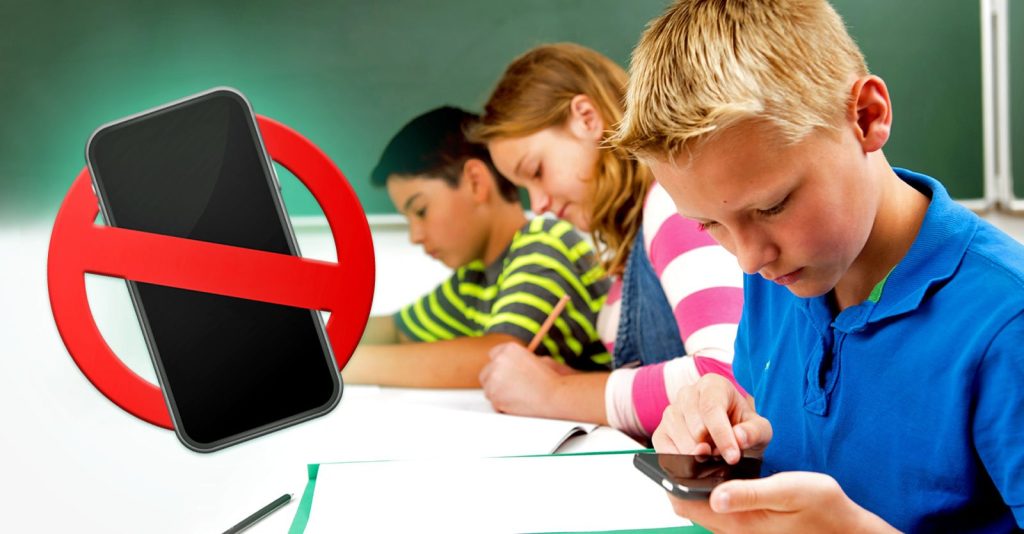“For a Growing Number of Kids, Back to School Means No Cellphones”

Originally published on Children’s Health Defense
More and more schools are banning the use of cellphones during the school day, citing research that links teen smartphone use to mental health harm.

More and more schools are banning the use of cellphones during the school day, citing research that links teen smartphone use to mental health harm.
Martha’s Vineyard Regional High School on Aug. 21 became one of the latest to adopt a new policy to lock away cellphones and other smart devices — such as earbuds, headphones and smartwatches — during school hours, reported the MV Times.
According to EdSource, schools are enacting such policies “to curb bullying, classroom distractions, and to combat addiction to the devices.”
Although procedures for the ban vary from school to school, the policy typically entails having students lock their cellphones and other personal devices in an electronic pouch that only school staff can open with a special magnet, or stow their phones in a locker upon arriving at school, EdSource said.
Since early summer, an increasing number of schools have opted to enforce such bans.
On June 18, the Los Angeles Unified School District (LAUSD), the second-largest district in the U.S., voted to ban cellphones during the school day starting in January 2025.
The vote came just one day after U.S. Surgeon General Vivek Murthy called for warning labels on social media platforms citing evidence that social media harms young people’s health.
Murthy cited research showing that roughly half of adolescents say social media makes them feel worse about their bodies and increases anxiety and depression.
“Schools should ensure that classroom learning and social time are phone-free experiences,” Murthy wrote in The New York Times.
Just one month later, principals from the New York City Public Schools — the country’s largest district, serving more than 1 million students — told Chalkbeat New York the school system is planning to institute a ban in February 2025.
However, New York City leaders — including Mayor Eric Adams — are still working out the logistical details of the ban, reported the Times. “We’re not there yet,” Adams said in an Aug. 27 press conference. “We have to get it right.”
Meanwhile, California Gov. Gavin Newsom on Aug. 13 urged every school district in the state to restrict cellphone use in classrooms as the new school year begins. California lawmakers are also considering a statewide ban, EdSource reported.
At least five states have already enacted school cellphone bans, including Florida, Indiana, Louisiana, Oklahoma and Ohio.
New York Gov. Kathy Hochul wants her state to be next. In March 2023, Hochul visited schools on a “listening tour” about youth’s mental health. “I know what I’ve heard,” Hochul said in a recent interview. “This is probably the one bipartisan — I want to say nonpartisan — issue that really is having a breakthrough.”
‘A step in the right direction’
Miriam Eckenfels-Garcia, director of CHD’s Electromagnetic Radiation (EMR) & Wireless program, applauded the efforts of school leaders and elected officials, such as Hochul and Newsom, who have pushed for cellphone bans at schools.
“Aside from the well-established dangers from excessive smartphone use,” she told The Defender, “the policy reduces children’s exposure to radiofrequency (RF) radiation — which is a step in the right direction.
Research shows that children, with their smaller heads and more fluid in their brains, absorb more RF radiation than adults.
Eckenfels-Garcia said she hopes more schools and states will pass cellphone bans.
Some parents have pushed back against the policy, saying they want to be able to hear from their kids in the case of an emergency, EdSource reported.
Others said it’s important that their kid can use a cellphone at school to monitor a required medicine or a health condition.
Sara Dingledy, principal at Martha’s Vineyard Regional High School, said her school would make exceptions in medical situations.
She acknowledged that students who are used to using social media constantly on their phones may initially be frustrated by the new rule — but they’ll likely benefit. “We know that if you persist through it, that the outcomes are really positive.”
LAUSD board member Nick Melvoin, who voted in favor of the ban told CNN banning cellphones is important because students have their heads in their hands walking down the hallways. “They’re not talking to each other or playing at lunch or recess because they have their AirPods in.”
Martha’s Vineyard Regional High School’s “Away for the day” policy reads:
“Research indicates that reducing phone usage addresses the current trend of social deprivation among adolescents by encouraging students to interact more with their peers in the hallways, in the cafeteria, and during down time.”
High cellphone use an addiction, not act of defiance
Santa Barbara Unified School District in California launched an “Off and Away” policy in 2021 that requires students to keep their electronics turned off and in their backpacks when at school.
Teachers say it’s had a huge impact on student engagement in the classroom and on building community.
Consequences for not complying with the policy range from students and parents being required to meet with school staff, to confiscating the electronics, Assistant Superintendent ShaKenya Edison told EdSource.
Students who struggle to keep their phone in their backpack may also be referred to a therapist, she said:
“One of the things that the (planning) committee was very clear about — we had doctors also on our committee, and psychologists — is that we need to treat cellphone usage as an addiction, not as defiance. … So it really is trying to get at the root of the dependency of the phone.”
During the COVID-19 pandemic, many students were isolated with their cellphones as the main source of socialization, Edison said. Some students use cellphones to cope with the anxiety of now being in a school setting or when they are struggling academically.
Schools should take further steps to reduce RF radiation
After LAUSD announced its plan to ban cellphones in schools, Brenda Martinez — a Los Angeles County resident and founding member of the nonprofit Fiber First LA — wrote to district leaders, urging them to not stop there.
“The banning of cell phone use in schools brings with it the opportunity to reevaluate the amount of RF radiation present in schools,” she said in her letter.
Given that the Federal Communications Commission still hasn’t responded to the court mandate to reevaluate its RF human exposure standards — “particularly as they apply to children,” Martinez said — it’s important that LAUSD take a proactive approach to reducing RF radiation exposure in its schools.
“This should include comprehensive, real-time measurements of cumulative RF exposure levels in classrooms with all devices operating simultaneously,” she added.
LAUSD leaders have not responded to Martinez.
One of our country’s most important freedoms is that of free speech.
Agree with this essay? Disagree? Join the debate by writing to DailyClout HERE.




